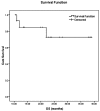A phase II trial of post-operative chemoradiotherapy for completely resected gastric cancer with D2 lymphadenectomy
- PMID: 25202423
- PMCID: PMC4156225
- DOI: 10.3892/ol.2014.2382
A phase II trial of post-operative chemoradiotherapy for completely resected gastric cancer with D2 lymphadenectomy
Abstract
The optimal post-operative adjuvant treatment for completely resected gastric cancer with D2 lymphadenectomy remains controversial. The present study was a phase II trial on post-operative chemoradiotherapy in 30 patients with gastric cancer. Patients with stage II to IV (M0) gastric cancer received two cycles of chemotherapy prior to and following chemoradiotherapy. The chemotherapy consisted of a 2-h infusion of oxaliplatin (100 mg/m2) and folinic acid (100 mg/m2), which was followed by a 46-h continuous infusion of 5-fluorouracil (5-FU; 2,400 mg/m2) through a portable pump, repeated every 3 weeks. The chemoradiotherapy consisted of 45 Gy of radiotherapy for 5 weeks and 5-FU continuous infusion (350 mg/m2/day). In total, 30 patients were enrolled in this study. All patients underwent the chemoradiotherapy treatment as planned. A total of 10 (33.3%) patients relapsed; two (6.7%) locoregional relapses and mediastinum metastases, four (13.3%) peritoneal relapses, and four (13.3%) distant metastases. The three-year overall survival and disease-free survival rates were 72.7 and 65%, respectively. The toxicities of chemotherapy and radiotherapy, consisting of neutropenia, nausea and hand-foot syndrome, were observed. In conclusion, post-operative chemoradiotherapy following complete resection of gastric cancer with D2 lymphadenectomy is feasible in a significant subset of patients.
Keywords: D2; chemoradiotherapy; gastric cancer; post-operative.
Figures
Similar articles
-
A phase II study of adjuvant S-1/cisplatin chemotherapy followed by S-1-based chemoradiotherapy for D2-resected gastric cancer.Cancer Chemother Pharmacol. 2016 Mar;77(3):605-12. doi: 10.1007/s00280-016-2973-2. Epub 2016 Feb 5. Cancer Chemother Pharmacol. 2016. PMID: 26846507 Clinical Trial.
-
Postoperative chemoradiotherapy for gastric cancer.Ann Oncol. 2003 Sep;14(9):1373-7. doi: 10.1093/annonc/mdg366. Ann Oncol. 2003. PMID: 12954575 Clinical Trial.
-
A new approach to delineating lymph node target volumes for post-operative radiotherapy in gastric cancer: A phase II trial.Radiother Oncol. 2015 Aug;116(2):245-51. doi: 10.1016/j.radonc.2015.07.010. Epub 2015 Jul 27. Radiother Oncol. 2015. PMID: 26228969 Clinical Trial.
-
Postoperative chemoradiotherapy versus postoperative chemotherapy for completely resected gastric cancer with D2 Lymphadenectomy: a meta-analysis.PLoS One. 2013 Jul 18;8(7):e68939. doi: 10.1371/journal.pone.0068939. Print 2013. PLoS One. 2013. PMID: 23874819 Free PMC article.
-
Indirect comparison showed survival benefit from adjuvant chemoradiotherapy in completely resected gastric cancer with d2 lymphadenectomy.Gastroenterol Res Pract. 2013;2013:634929. doi: 10.1155/2013/634929. Epub 2013 Oct 1. Gastroenterol Res Pract. 2013. PMID: 24194750 Free PMC article. Review.
Cited by
-
Between evidence and new perspectives on the current state of the multimodal approach to gastric cancer: Is there still a role for radiation therapy?World J Gastrointest Oncol. 2018 Sep 15;10(9):271-281. doi: 10.4251/wjgo.v10.i9.271. World J Gastrointest Oncol. 2018. PMID: 30254722 Free PMC article. Review.
-
Age as a modifier of the effects of chemoradiotherapy with infusional 5-fluorouracil after D2 dissection in gastric cancer.Aging (Albany NY). 2021 Jul 5;13(13):17337-17348. doi: 10.18632/aging.203223. Epub 2021 Jul 5. Aging (Albany NY). 2021. PMID: 34226296 Free PMC article.
-
Outcomes of Neoadjuvant Chemoradiation in Patients with Gastro-esophageal Junction Adenocarcinoma: a Retrospective Cohort Study in Iran.J Gastrointest Cancer. 2019 Dec;50(4):907-912. doi: 10.1007/s12029-018-0155-7. J Gastrointest Cancer. 2019. PMID: 30402826
References
-
- Jemal A, Bray F, Center MM, et al. Global cancer statistics. CA Cancer J Clin. 2011;61:69–90. - PubMed
-
- Park SH, Kim DY, Heo JS, et al. Postoperative chemoradiotherapy for gastric cancer. Ann Oncol. 2003;14:1373–1377. - PubMed
-
- GASTRIC (Global Advanced/Adjuvant Stomach Tumor Research International Collaboration) Group. Paoletti X, Oba K, Burzykowski T, et al. Benefit of adjuvant chemotherapy for resectable gastric cancer: a meta-analysis. JAMA. 2010;303:1729–1737. - PubMed
-
- Macdonald JS, Smalley SR, Benedetti J, et al. Chemoradiotherapy after surgery compared with surgery alone for adenocarcinoma of the stomach or gastroesophageal junction. N Engl J Med. 2001;345:725–730. - PubMed
LinkOut - more resources
Full Text Sources
Other Literature Sources


